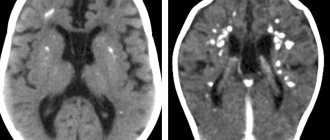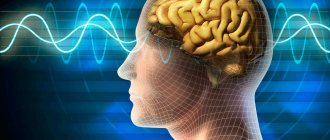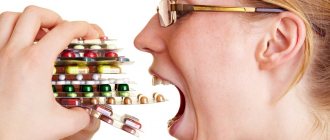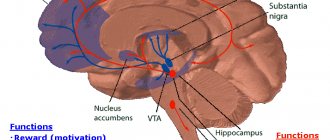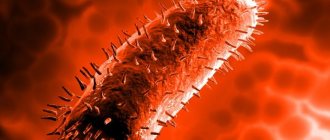Meningism is a syndrome that manifests itself in infectious diseases, poisoning and traumatic brain injuries. It is characterized by irritation of the membranes of the brain. Some people confuse the problem with meningitis, but there is a difference in their clinical pictures. The symptoms of meningitis appear clearly and quite clearly.
Do not self-medicate. At the first signs of illness, consult a doctor.
- Etiology
- Symptoms
- Diagnostics
- Treatment
- Possible complications
- Prevention
Most often, meningism occurs in children with fever; in rare cases, it is diagnosed in adults. According to ICD-10, meningism is coded R29.1.
Etiology
The human immune system protects the brain very well. But if it happens that with a weak immune system, the infection still gets there, the body still tries to fight it. Paradoxically, this only makes the situation worse.
Due to the fact that at this time red and white cells begin to be produced in excess and enter the brain, inflammatory processes begin that can result in edema. If nothing is done, the access of blood and oxygen to the brain will be blocked. The further development of the infectious disease will worsen.
Clinicians identify the following causes of meningism:
- poisoning by chemical elements;
- allergic reaction to medications used;
- fungal infections;
- the presence of various parasites in the patient’s body;
- benign formations or oncology - boils on the face or neck can cause the syndrome;
- infectious diseases that affect the area adjacent to the brain, for example, otolaryngological diseases;
- diabetes;
- uncontrolled use of medications that affect the immune system;
- unfavorable way of life.
Children's meningism syndrome can even occur due to ARVI and high blood pressure.
Meningitis and meningism
Meningitis
Based on the nature of the inflammatory process in the meninges and changes in the cerebrospinal fluid, serous and purulent meningitis are distinguished. In serous meningitis, lymphocytes predominate in the cerebrospinal fluid; in purulent meningitis, neutrophilic pleocytosis predominates. According to pathogenesis, primary and secondary meningitis are distinguished. Primary meningitis develops without a previous general infection or infectious disease of any organ; secondary meningitis is a complication of a general or local infectious disease. According to the localization of the process, there are generalized and limited meningitis, at the base of the brain - basal, on the convex surface - convexital. Depending on the development and course, fulminant, acute, subacute and chronic meningitis are distinguished, and according to the degree of severity - mild, moderate, severe and extremely severe forms. According to the etiology, there are bacterial (meningococcal, pneumococcal, staphylococcal, tuberculosis, etc.), viral (acute lymphocytic choriomeningitis caused by enteroviruses ECHO and Coxsackie, mumps, etc.), fungal (candidiasis, turulosis, etc.) and protozoal meningitis. In newborns, meningitis is most often caused by group B streptococci, Listeria monocytogenes and Escherichia coli, in those under 1 year of age - by Haemophilus Influenzae, in older children and adolescents - by meningococci (Neisseria meningitidis), and in older people - by streptococci (Streptococcus pneumonia).
The symptoms of all forms of acute meningitis have much in common, regardless of etiology. The diagnosis of meningitis is established in the presence of three syndromes simultaneously:
- general infectious disease;
- meningeal (meningeal);
- changes in the cerebrospinal fluid characteristic of inflammation.
The presence of one of them does not yet provide grounds for diagnosing meningitis. Thus, meningeal symptoms may be caused by irritation of the membranes (meningismus). An increase in the number of cells in the cerebrospinal fluid may be due to a reaction of the membranes to a tumor or bleeding. The diagnosis is clarified based on the study of cerebrospinal fluid and the use of bacteriological, virological and other methods for diagnosing infectious diseases, taking into account the epidemiological situation and the characteristics of clinical manifestations.
General infectious symptoms include chills, fever, usually increased body temperature, changes in peripheral blood (leukocytosis, increased ESR, etc.), and sometimes skin rashes. The pulse may be slow in the early stages, but becomes faster as the disease progresses. The breathing rhythm may be incorrect, the frequency may be increased.
Meningeal syndrome is characterized by headache, vomiting, general hyperesthesia, meningeal posture, stiffness of the neck muscles, Kernig's symptoms, Brudzinski's symptoms, zygomatic Bechterew's symptom, etc. Increasing headache is the initial symptom. It is caused by irritation of pain receptors in the meninges and intracerebral vessels due to the inflammatory process, the action of a toxin and mechanical irritation as a result of increased intracranial pressure. The headache is sharp, intense, bursting, tearing in nature. It can be diffuse or predominate to a greater extent in the frontal and occipital regions, radiate to the neck, back, be accompanied by pain in the spine, and sometimes spread to the lower extremities. In the early stage, vomiting may be observed, not associated with food intake, which occurs during intensification of the headache. Convulsions occur frequently in children, but rarely in adults. Psychomotor agitation, delirium and hallucinations are possible, but as the disease progresses, they give way to drowsiness and stupor, which can then progress to coma.
Meningeal (meningeal) symptoms , which are based on reflex muscle tension, arise as a result of irritation of the meninges. The most important signs are the following.
Rigidity of the neck muscles is observed in the early stages almost constantly. Rigidity is determined if the doctor places his hand under the back of the patient's head and tries to passively flex the head so that the chin moves closer to the chest. In this case, resistance is felt due to tension in the extensor muscles of the neck, and an attempt to overcome this resistance causes pain. In severe cases of meningitis, the head is thrown back, the stomach is retracted, the anterior abdominal wall is tense, the legs are brought to the stomach, and opisthotonus is observed.
Kernig's sign is somewhat less common. For the patient lying on his back, the leg is bent at a right angle at the hip and knee joints; an attempt to passively extend the leg at the knee joint with the hip bent fails due to tension in the posterior thigh muscles, the patient experiences pain in the lower back and leg. Trismus, zygomatic ankylosing spondylitis (local pain when tapping along the zygomatic arch), pain in the eyeballs when pressed and moving them, skin hyperesthesia, increased sensitivity to noise, loud conversation, odors, Brudzinski's symptom (upper and lower) are also noted. Patients prefer to lie motionless with their eyes closed in a darkened room.
In infants, tension and protrusion of the anterior fontanel are observed, a symptom of Lesage’s “suspension”: the child is taken by the armpits with his hands and lifted, as a result, an involuntary pulling of the legs towards the stomach occurs due to bending them at the hip and knee joints.
Symptoms
All signs indicating meningism occur quickly, so it will not be difficult for the doctor to recognize them.
Symptoms of developing meningism:
- a sick child has chills that turn into fever;
- mental disorders: confusion, amnesia, sometimes mental disorders appear;
- nausea, sometimes with severe vomiting;
- photophobia occurs - children in this case lie with their faces turned to the wall, completely covered with a blanket;
- very severe pain in the head, the patient reacts painfully to sounds, movements and light - limited movements appear when bending the neck, sometimes it even becomes impossible;
- it is impossible to straighten a leg that is bent at the knee;
- if you put the patient on the bed and try to tilt him towards his chest, his legs themselves will begin to bend at the knees;
- the nasolabial triangle becomes pale;
- the patient's concentration deteriorates and absent-mindedness appears;
- with this diagnosis in an infant, the child exhibits anxiety and concern, he is overly receptive to sounds and touches, and his sleep is disturbed;
- the patient refuses to eat and drinks liquids in large quantities;
- breathing is impaired;
- pressure readings drop and pulse quickens;
- a rash appears on the skin with redness;
- convulsions begin.
There are other symptoms that may appear depending on the underlying cause that caused the meningismus.
Meningism: causes and possible diseases
Typically, meningism occurs with meningitis, often as the first symptom. The triggers for such inflammation of the meninges are usually certain bacteria or viruses, less often fungi or parasites. Not every meningism is necessarily accompanied by meningitis. For example, sick newborns often do not have neck stiffness.
In addition to inflammation from pathogens, there are other triggers that can cause irritation of the meninges and subsequently meningism. These include:
- Subarachnoid hemorrhage: a type of stroke with hemorrhage between the inner and middle meninges. The main symptom is a sudden, very severe headache.
- Meningiosis neoplasty: dislocation of tumor cells in the meninges; may occur in the later stages of various types of cancer.
- Sinus thrombosis: blood clots in the large blood outlets (sinuses) of the brain. They are located in the hard meninges.
- Sepsis ("blood poisoning"): the spread of bacteria or fungi from a site of inflammation throughout the bloodstream and resulting in infection of various organs (such as the meninges).
- Sunstroke: An inflammatory reaction of the meninges due to prolonged exposure to direct sunlight on the head and neck.
- Lead poisoning. Possible consequences include other seizures and inflammation of the blood vessels in the brain (lead encephalopathy). Of course, this sometimes leads to irritation of the meninges.
Pseudomeningism
If painful stiff neck is caused by factors other than irritated meninges, it is called pseudomeningismus. Causes of such pain when bending the neck include, for example, fractures, disc herniation or signs of wear and tear (arthrosis) in the cervical spine. Additionally, migraines or tumors can lead to pseudomeningismus.
Diagnostics
First, the doctor visually examines the patient - in this way, the presence of fever, rapid heartbeat or altered consciousness can be determined.
The main diagnostic procedure is lumbar puncture. Once the cerebrospinal fluid is obtained, it is carefully examined. If necessary, the doctor prescribes additional examinations. It is mandatory to carry out standard laboratory tests - CBC, LBC, general urinalysis.
Lumbar puncture
Treatment
It is necessary to begin treatment for this syndrome immediately after the first signs appear. This should only be done by a qualified specialist in a hospital setting. Therapy will be aimed at reducing intracranial pressure.
Mainly used:
- medications for oral administration;
- intramuscular medications to help relieve swelling.
Before prescribing medications, the doctor determines the cause of the syndrome. Each cause is treated with specific means, for example:
- for a bacterial disease, therapy is carried out using broad-spectrum antibiotics;
- For a viral disease, antiviral drugs are prescribed.
Treatment is also carried out by other means that can:
- reduce high body temperature;
- relieve pain;
- reduce the risk of seizures.
If for some reason the patient does not take the drugs on his own, they are injected into his spinal canal.
Health care
When it comes to treating this syndrome, there is no need to hesitate; treatment of meningism must be carried out quickly, competently and promptly. Treatment of this syndrome is carried out in a hospital and is aimed at reducing the pressure inside the skull.
Most often this is drug therapy, as well as intramuscular injection of fluid that can relieve brain swelling.
In order to prescribe medications, the doctor must know what exactly caused the meningism. So, in the case of a bacterial origin of the infection, the patient is prescribed antibiotics of the broadest spectrum; if the infection is caused by a virus, then antiviral drugs.
Other drugs prescribed to the patient are intended to reduce body temperature, relieve pain, reduce shock syndrome and convulsions.
In the event that the patient cannot take the medicine on his own, the drugs are injected directly into the spinal canal.
If meningism is not recognized in time and treated, it will develop into a more serious and significant disease - meningitis, which is very often accompanied by complete paralysis of the limbs, epileptic seizures, and other neurological problems.
It is important to know! The consequences and complications of meningism may not manifest themselves immediately, but only years later.
Prevention
To prevent the disease, you should adhere to the following recommendations:
- you should protect yourself from contact with people sick with infectious diseases;
- if an epidemic of the disease is declared, then it is necessary to avoid “crowds”, especially where there are small children - if this cannot be done, you need to carefully observe personal hygiene;
- in case of an epidemiological situation, you should wear a gauze bandage on the street;
- all diseases must be treated promptly and correctly;
- carry out wet cleaning of the premises in a timely manner;
- strengthen the immune system.
To cope with this insidious syndrome, it is necessary to follow all preventive measures and timely treat emerging diseases.
For prevention purposes
Compliance with the following rules will help protect against meningism, and in the future, against meningitis:
- if a loved one is sick, then you need to avoid any contact with him, and if this is not possible, then after visiting the sick person, wash your hands thoroughly and observe the rules of personal hygiene;
- if an outbreak of this infection has begun at your place of residence, then you need to avoid places with large crowds of people, especially with small children; if this cannot be avoided, then after each visit to such a place you need to thoroughly wash your hands and face with soap;
- if an outbreak of the disease occurred in a barracks or dormitory, then you must use a mask when leaving your room;
- promptly treat absolutely any disease;
- monitor the hygiene of your home, fight insects and rodents;
- maintain the immune system in order;
- if there was close contact with a sick person, then you need to go to a medical institution where they will prescribe a course of antibiotics;
- When traveling to countries where this syndrome is common, it is advisable to take a course of antibiotics for prevention. They should only be prescribed by the attending physician;
- get into the habit of washing your hands as often as possible: after visiting the toilet, after contact with street animals, after coming home from the street, before eating;
- vegetables and fruits brought from the store also need to be washed before eating them;
- cover your mouth when you cough or sneeze.
It is important to know: some people prefer to protect themselves from meningitis and meningism with vaccinations, however, this is not the right way out of the situation. These diseases have many pathogens, and it is impossible to protect against them all with just one vaccination.
Thus, meningism is a very insidious syndrome that can cause a lot of health problems to its owner. To prevent this from happening, you need to carefully follow preventive measures and consult a doctor on time.
